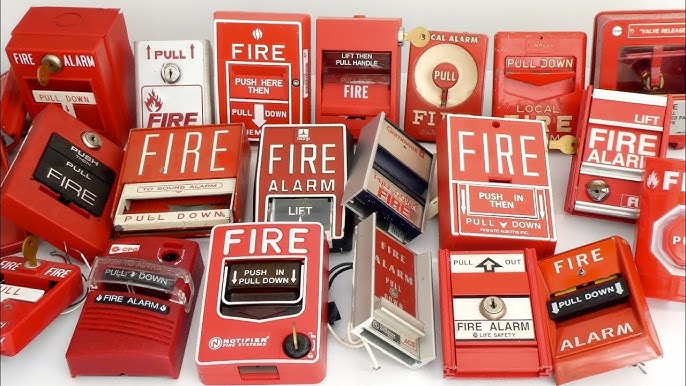Technology
Fire Pull: How It Works and Why It’s Essential for Fire Safety

Introduction to Fire Pull
In a world where safety is paramount, fire pull systems play an important role in ensuring that we’re prepared for emergencies. These manual devices allow individuals to trigger a fire alarm, alerting everyone in a building to evacuate immediately. Whether in schools, offices, or commercial buildings, fire pull systems are a vital component of a well-organized fire safety strategy. But what exactly is a fire pull, and why is it so essential? Let’s dive into these questions and uncover the crucial functions of fire pull systems in our everyday lives.
What is a Fire Pull?
A fire pull is a simple yet effective safety device used to activate a fire alarm system during an emergency. It is typically located in easily accessible areas, such as hallways, near exits, or stairwells. The mechanism involves pulling a handle or lever to activate an alarm, which in turn alerts building occupants to the presence of a fire. Though seemingly straightforward, fire pulls are designed to be intuitive and quick to use in times of crisis.
How Fire Pulls Contribute to Fire Safety
Fire pull systems contribute significantly to fire safety by providing an immediate means of alerting everyone in a building. In the event of a fire, every second counts. When someone notices a fire, the ability to quickly pull a fire alarm ensures that others in the vicinity are informed without delay. This rapid notification helps prevent panic, facilitates a quick evacuation, and even allows for the swift dispatch of emergency services to the scene.
The History Behind Fire Pulls
The use of fire pulls dates back to the 19th century, when they were first introduced to help alert people in large buildings or cities about the outbreak of fire. Before fire pulls, people relied on loud bells or whistles to signal an emergency, but these methods were often ineffective. The innovation of manual fire pull systems provided a more reliable means of notifying everyone in the area about the danger. Over time, these systems evolved, incorporating new technologies to increase their efficiency and reliability.
Why Are Fire Pulls Important?
Fire pulls are a critical element in fire safety because they provide an immediate method for alerting others about the presence of a fire. In public spaces, where individuals might not be aware of a fire until it’s too late, having fire pulls installed throughout the building can save lives. In places like schools and hospitals, where the population may include vulnerable individuals, fire pulls are indispensable. Their simplicity and reliability make them an essential part of any fire emergency plan.
Fire Pull vs. Fire Alarm
While both fire pulls and fire alarms serve the same general purpose of alerting people to a fire, the difference lies in how they are triggered. A fire pull is a manual device that requires a person to physically activate it by pulling a lever or handle. On the other hand, fire alarms can be automatic, triggered by heat or smoke detectors without any human interaction. Together, both systems create a layered safety approach that ensures fires are detected and responded to as quickly as possible.
Types of Fire Pull Systems
There are two main types of fire pull systems: manual and automated. Manual systems, as described earlier, require a person to pull a lever to trigger the alarm. Automated fire pull systems, however, are integrated with smoke or heat detection systems, which automatically activate the alarm when they detect signs of a fire. These systems are increasingly popular in modern buildings, providing an added layer of security and ensuring a quicker response to fire emergencies.
Where Should Fire Pulls Be Installed?
The placement of fire pulls is crucial for their effectiveness. They should be installed in visible and easily accessible areas, such as near exits, stairwells, and hallways. Building codes often provide specific guidelines on where fire pulls must be placed to ensure they are reachable in the event of an emergency. Fire pulls should be clearly marked and free from obstruction, allowing anyone, regardless of their age or physical ability, to easily activate the alarm.
How to Operate a Fire Pull System
Operating a fire pull system is straightforward. When someone detects a fire, they should immediately locate the nearest fire pull, which is usually a red box with a clearly marked handle. By pulling the lever or handle downwards, the system is activated, sending out an alarm to alert everyone in the building. It’s important to remember that fire pulls should only be used in the event of an actual emergency and should not be tampered with.
Fire Pull Maintenance: What You Need to Know
Fire pulls, like any other safety equipment, require regular maintenance to ensure that they work when needed. Maintenance includes periodic checks to ensure the mechanism is functional and the alarm system is connected properly. It’s also essential to inspect the surrounding area to ensure there are no obstructions. Building owners and facility managers are typically responsible for scheduling regular inspections and testing fire pulls to comply with local safety regulations.
Signs That Indicate a Fire Pull System Needs Repair
While fire pulls are generally reliable, like all mechanical devices, they may sometimes require repairs. Common signs that a fire pull system needs attention include a malfunctioning lever, loose components, or an alarm that doesn’t sound when activated. If a fire pull appears to be damaged or worn out, it’s important to get it repaired immediately to prevent failure during an actual fire emergency.
Common Myths About Fire Pulls
There are several myths surrounding fire pulls, one of which is that they are only for large buildings. In fact, fire pulls are essential in any building, regardless of size, to ensure the safety of everyone inside. Another myth is that they are automatically triggered when smoke or heat is detected. While fire pulls may be integrated with automatic systems, they still require manual activation in most cases.
Legal Regulations Surrounding Fire Pulls
Fire pull installations are governed by local fire safety codes and regulations. These laws outline where fire pulls must be located, how often they need to be tested, and who is responsible for their maintenance. In many regions, non-compliance with fire safety codes can result in fines or penalties, so it’s crucial to follow the guidelines to maintain the safety of all building occupants.
How Often Should Fire Pulls Be Tested?
Fire pull systems should be tested regularly to ensure they are functioning correctly. The recommended frequency for testing varies by location, but it is generally advised to conduct a test at least once a month. Testing involves ensuring that the alarm is triggered when the lever is pulled and verifying that the system is connected to the building’s alarm network.
Fire Pulls in Commercial Buildings
In commercial buildings, fire pulls are essential for safeguarding employees, visitors, and customers. With large numbers of people in office spaces, malls, and restaurants, fire pulls help ensure a quick evacuation in the event of a fire. In these settings, it’s also crucial to provide employees with proper fire safety training so they can respond promptly to emergencies.
Fire Pulls in Residential Areas
In residential buildings, including apartments and houses, fire pulls may not always be present in the same way they are in commercial spaces. However, in larger apartment complexes or multi-family dwellings, fire pulls can be lifesaving. They ensure that even in the case of a delayed alarm system or unnoticed fire, the danger is communicated to everyone as soon as possible.
Fire Pulls vs. Modern Fire Safety Systems
Modern fire safety systems, like smoke detectors and sprinklers, are increasingly being used to complement fire pull systems. While these systems automate the detection and suppression of fires, fire pulls remain a valuable tool in ensuring that everyone in the building is notified in the fastest way possible. Combining both manual and automated systems helps create a comprehensive safety approach.
Training Employees to Use Fire Pulls
Employee training is essential for effective fire safety management. Employees should be trained on how to operate fire pull systems, understand evacuation routes, and participate in regular fire drills. Proper training ensures that, in the event of a fire, everyone knows exactly what to do and where to go to ensure their safety.
What to Do After a Fire Pull Is Activated
Once a fire pull is activated, it’s important to remain calm and follow the building’s evacuation procedures. All occupants should immediately exit the building, avoiding elevators and taking the nearest exit route. Firefighters and emergency personnel will arrive to assess the situation, so it’s crucial to follow their instructions.
Fire Pull Systems in Large Buildings
Large buildings present unique challenges when it comes to fire safety. In such settings, fire pulls should be strategically placed at various points to ensure they are easily accessible from any location. Additionally, these systems should be integrated with fire alarms, sprinklers, and other safety measures to offer comprehensive protection.
The Role of Fire Pulls in Multi-Story Buildings
In multi-story buildings, fire pull systems play an even more critical role. These buildings often have numerous floors with multiple exits and stairwells, and ensuring that all occupants can quickly reach a fire pull is vital. Proper signage and clear instructions can help guide individuals to the nearest fire pull during an emergency.
Benefits of Fire Pull Systems in Schools and Hospitals
In schools and hospitals, fire pulls are essential for the safety of vulnerable individuals. Schools often have large student populations, while hospitals may have patients who are unable to evacuate on their own. Fire pulls ensure that everyone, including those with mobility challenges, can quickly be alerted to a fire and evacuate safely.
Innovations in Fire Pull Technology
In recent years, fire pull technology has evolved to incorporate more advanced features, such as remote monitoring and integration with other building systems. These innovations help enhance fire safety by providing more efficient ways to detect fires and alert building occupants.
Frequently Asked Questions About Fire Pulls
What is the main purpose of a fire pull?
The primary purpose of a fire pull is to manually activate a fire alarm system, alerting everyone in a building to the presence of a fire and ensuring an immediate evacuation.
How do you know if a fire pull system is working?
A fire pull system should be regularly tested. If the lever moves easily and triggers the fire alarm when pulled, the system is working properly.
Are fire pulls required by law?
Yes, fire pulls are generally required in most public buildings and commercial spaces to comply with fire safety regulations.
Can fire pulls be automated?
While traditional fire pulls are manual, many modern systems integrate automated features for quicker fire detection.
What happens if a fire pull is activated accidentally?
If a fire pull is activated accidentally, the alarm will sound. It’s important to follow evacuation procedures and ensure that emergency services are notified.
Can fire pulls be used for other emergencies?
Although fire pulls are designed for fire emergencies, they are sometimes used to trigger alarms for other emergencies, such as gas leaks or hazardous material spills.
Conclusion
In conclusion, fire pull systems are a crucial part of building safety, offering a reliable means of alerting everyone to the presence of a fire. These simple yet effective devices have saved countless lives by ensuring that building occupants can evacuate quickly and safely. By understanding the importance of fire pulls, knowing how they work, and ensuring they are properly maintained, we can all contribute to a safer environment. Always remember, when it comes to fire safety, being prepared can make all the difference.
Technology
Why AI Employee Tracking Alone Can’t Build a Thriving Company

Imagine running a small business where every keystroke, email, and coffee break is tracked by an algorithm. Sounds efficient, right? But when I helped a friend streamline her startup’s operations in 2025, we quickly learned that relying solely on AI employee tracking—like the best employee tracking software—can backfire. While tools like Controlio offer powerful insights into productivity, they miss the human spark that makes a company truly great. Let’s explore why AI tracking alone isn’t enough and what really drives a thriving workplace.
The Limits of AI Tracking: Numbers Over Nuance
AI employee tracking tools, like the Controlio app, are designed to boost efficiency by monitoring metrics such as time spent on tasks or app usage. They’re fantastic for spotting patterns—say, identifying when your team’s bogged down by repetitive work. But here’s the catch: they reduce people to data points. When my friend’s startup leaned too heavily on tracking software, her team felt like cogs in a machine, not valued contributors.
Research shows that excessive surveillance can tank morale. A 2024 Cornell study found employees under AI monitoring reported higher stress and lower productivity compared to those with human oversight. Why? Algorithms lack context. They can’t tell if someone’s late because they were helping a colleague or if a long email thread was a creative brainstorm. Over-reliance on AI risks alienating your team, stifling the very innovation you’re trying to foster.
Human Connection: The Heart of a Great Company
Great companies aren’t built on dashboards alone—they thrive on trust, collaboration, and shared purpose. I saw this firsthand when my cousin’s catering business hit a rough patch. Instead of doubling down on tracking tools, she hosted weekly team huddles to share ideas and celebrate wins. The result? Her staff felt heard, and turnover dropped by 30% in six months.
AI can’t replicate the empathy of a manager who notices a team member’s off day and offers support. It can’t spark the camaraderie of a spontaneous lunchroom chat that leads to a breakthrough idea. Building a strong company culture means prioritizing relationships over reports. Encourage open communication, mentorship, and team-building—elements no algorithm can quantify.
Creativity and Innovation: Beyond the Algorithm’s Reach
AI tracking excels at measuring output but struggles with intangibles like creativity and emotional intelligence. When I worked with a local design agency, we noticed their AI tool flagged “unproductive” hours spent sketching or brainstorming. Yet those moments birthed their best campaigns. Over-focusing on metrics can suffocate the creative freedom that drives innovation.
A 2025 McKinsey report highlights that companies fostering experimentation and collaboration outperform those obsessed with efficiency metrics. Give your team room to take risks—whether it’s prototyping a bold idea or debating a new strategy. Tools like Controlio can track time, but they can’t measure the spark of a game-changing idea born over coffee.
Trust vs. Surveillance: Striking the Right Balance
Constant monitoring erodes trust, and trust is the glue of any great company. Employees who feel watched like hawks are less likely to take initiative or share honest feedback. A Reddit thread from 2024 echoed this, with workers venting about AI tracking making them feel “on edge” and less loyal to their employers.
When my friend’s startup introduced transparent policies about how tracking data would be used—like improving workflows, not punishing pauses—her team relaxed. Use AI tools to empower, not police. Share insights with employees, involve them in decisions, and set clear boundaries. For example, use Controlio to optimize schedules, but pair it with regular check-ins to show you value their input, not just their output.
Ethical Concerns: Avoiding Bias and Burnout
AI isn’t neutral—it can amplify biases or push employees toward burnout. A 2025 Business Insider report noted that poorly designed AI tracking systems may unfairly flag certain groups, like remote workers, due to inconsistent data patterns. Plus, an overemphasis on productivity metrics can lead to exhaustion, with 60% of surveyed employees reporting stress from constant monitoring.
To counter this, regularly audit your AI tools for bias and ensure they align with your company’s values. Promote work-life balance with policies like flexible hours or mental health days. My friend learned this the hard way when her team’s morale dipped—she countered it with wellness programs, and productivity soared.
Final Note: Blend Tech with Heart for Lasting Success
AI employee tracking, like the Controlio app, is a powerful tool for streamlining operations, but it’s not a magic bullet. Great companies are built on trust, creativity, and human connection—qualities no algorithm can fully capture. My friend’s startup flourished when she balanced tech insights with genuine care for her team, proving that people, not just data, drive success.
In 2025, embrace AI as a helper, not a boss. Use tools to spot inefficiencies, but invest in mentorship, open dialogue, and a culture where employees feel valued. That’s the recipe for a company that doesn’t just survive but thrives. Ready to strike that balance? Start exploring smarter ways to blend tech and heart today.
Technology
“Duster SUV: Complete Guide to Features, Specs, Safety, and Buying Tips”

Introduction
The word Duster brings to mind a simple, sturdy SUV many people trust. This car feels practical and honest. It fits families, adventurers, and daily drivers alike. People praise its space, its simple tech, and its low cost to own. In this article, I explain what makes the Duster special. I use clear, short sentences that are easy to read. I give real facts, helpful tips, and plain advice. I show numbers where they matter and share trusted insights. Read on for design notes, engine choices, safety facts, buying tips, and six common questions. By the end, you will know whether this model suits your life and budget.
What it is
The Duster is a compact SUV that blends value with practicality. It started as a no-nonsense crossover people could afford. Over time, it grew more refined while keeping its core strengths. Today it comes in several versions for many markets. You can find models with mild-hybrid help or classic petrol engines. The Duster aims to offer a roomy cabin without high costs. It targets buyers who want a solid SUV without fancy frills. That clear purpose shaped its design and its price strategy. Many drivers see it as an honest car that gives you what you need.
Design and styling
The look of this compact SUV mixes toughness and neat lines. It keeps a broad stance and raised wheel arches. The front often shows a strong light design and simple grille work. Inside, the layout favors durable materials and sensible storage. The exterior has roof bars and protective cladding for outdoor use. Designers focused on useful features over delicate trims. That choice helps keep repair costs low over time. If you want flashy leather and soft touch everywhere, this might not be it. But if you want a rugged, honest SUV ready for trips, it fits the bill.
Engines and powertrains
You can pick from small petrol engines and mild-hybrid setups. Some markets also see a larger 2.0 petrol and 4×4 option. Engine output varies by region and trim level. The simplest petrol is easy to maintain and quite fuel friendly. The mild-hybrid choice helps with short town runs and saves fuel. For tougher terrain, a 4×4 option offers extra traction and control. Manuals, CVTs, and automatic options appear depending on model year. Always check exact engine details where you live before you buy. Each version balances performance and fuel economy differently.
Fuel economy and efficiency
This SUV can be quite frugal, depending on the engine you pick. Smaller petrols often return good fuel efficiency in mixed driving. Hybrid versions claim better urban economy and lower emissions. The mild-hybrid systems help reduce engine load at idle and in slow traffic. Real-world economy will change with load, terrain, and driving style. Drivers who favor calm acceleration often see the best numbers. If you plan long highway trips, choose an engine tuned for steady cruising. Official figures give a useful baseline when you compare trims.
Off-road capability and ground clearance
Raised ride height makes this model useful on rough tracks and muddy roads. Some trims list over 200 mm of ground clearance for easy approach. Four-wheel drive models include terrain selectors for snow, mud, and sand. The suspension is tuned for resilience rather than sporty handling. Protective skid plates help against rocks and bumps on trails. That setup gives confidence for weekend camping and farm access roads. Still, it is a compact SUV, not a heavy-duty truck. Match expectations to the terrain you’ll tackle most often.
Interior space and practicality
The cabin focuses on smart storage and easy cleaning for busy lives. Boot volume ranges from mid to large capacity, depending on trim and engine. With rear seats folded, the load area grows to take longer items. The double-floor and compartments help keep gear tidy on long trips. Front and rear passengers get sensible legroom for the class. Infotainment supports phone mirroring in many trims for maps and music. Materials lean toward durable plastics and simple switches for reliability. This makes the interior practical for family life and outdoor adventures.
Safety and ratings
Safety equipment varies by market and trim level. Many versions now come with driver aids like lane assist and emergency braking. Older models had fewer safety features, but recent upgrades improved this area. Buyers should look for multiple airbags, stability control, and strong crash ratings. Always compare the fitment of safety tech between trims before you buy. Choosing a version with active safety aids makes daily driving more secure. Families especially benefit from these modern protections.
Ownership and running costs
One big strength is the low cost of ownership compared to rivals. Insurance and repair parts tend to be cheaper for this model. Service intervals are reasonable and many mechanics know the platform. Fuel bills depend on engine and driving habits, but smaller engines keep costs down. Resale value varies by region and trim, so check local used prices. Warranty length also differs by country. If you plan to buy used, ask for full service history and check for rust or heavy off-road wear. Overall, the Duster aims to be affordable to run and repair.
Trim levels and options
Manufacturers offer a clear set of trims from basic to well-equipped. Basic trims give the essentials to keep the price low. Mid trims add nicer infotainment, alloy wheels, and comfort items. Top trims may include leather-effect seats and advanced driver aids. Some regions add unique packs like camping gear or cargo versions. You can often choose bar-style roof racks and protective mats. Decide which features you need before picking a trim. That saves money and avoids paying for extras you will not use.
How it compares with rivals
Against similar compact SUVs, the Duster wins on price and practicality. Some rivals offer fancier cabins or sharper handling. Others will have stronger dealer networks or better long-term resale. If you want rugged looks and simple tech, this model often leads. If you prefer premium fit and more silence inside, look at other brands. Compare boot size, fuel numbers, and safety kit when you shop. Test drives across a few models reveal which feels best for your needs.
Maintenance, tips, and common issues
Routine checks keep this SUV reliable for many years. Watch for common wear items like brake pads and suspension bushes. Keep the air filter fresh if you drive dusty roads often. For long trips, check belts and fluid levels before you leave. Choose genuine parts when possible, but good aftermarket parts can save money. If the car has a CVT, follow the service rules for transmission oil. Joining owner groups can give you tips on common fixes. These small steps help avoid surprises and control repair costs.
Customization and accessories
Owners often add roof racks for bikes and kayaks. Boot liners and mudflaps protect the paint and the interior. For camping, simple tents and sleep packs make trips easier. All-weather mats help keep the cabin clean in winter. Some dealers sell protection packs with skid plates and light guards. Choose only tested accessories that fit factory mounts. Proper accessories raise the car’s usefulness without harming safety. A small investment in the right bits makes the vehicle far more versatile.
Environment and hybrid tech
Newer mild-hybrid and hybrid setups reduce fuel use in town. The hybrid option often lets the engine rest for short electric-only runs. This suits stop-and-go traffic in cities well. Hybrid tech also helps reduce emissions and fuel bills. Still, the fuel gains depend heavily on how you drive. Long highway trips may show less benefit than urban driving. If your commute is mostly city, a hybrid variant can cut costs. Always review real-world test results to compare engines before buying.
Best use cases and who should buy it
The Duster fits families who want space and low costs. It serves people who enjoy weekend trips off the beaten track. Small business owners like cargo versions for city deliveries. First-time SUV buyers get easy driving and affordable upkeep. Buyers who want full luxury or sporty handling should consider other models. If you value honest design, big boot space, and rugged style, this one is sensible. Matching the trim to your needs ensures good value for the money.
Conclusion — is it right for you?
In short, the Duster blends value, space, and rugged practicality. It is not the quietest or plushest cabin in its class. But it will carry people, luggage, and pets without fuss. If low running costs matter, it can be a smart choice. Read the spec sheet carefully in your country before you buy. Test drive the same engine and trim you plan to purchase. Check local prices and dealer support for your area. If you like simple, practical design and honest value, this SUV may fit your life.
FAQs
Q1 — What is the best engine for daily driving?
A small petrol or mild-hybrid often works best for daily use. These choices give low city fuel use. They feel calm and save money on regular runs. If you carry heavy loads often, choose the bigger petrol. For mixed town and highway trips, a mild-hybrid balances economy and comfort.
Q2 — How much boot space does it offer?
Boot space depends on trim and engine choices. Typical figures start around mid-hundreds of litres. Folding the rear seats adds a lot of cargo room. Official brochures list exact litres for each version. Always confirm the details for the model in your region.
Q3 — Is the four-wheel drive model worth it?
Four-wheel drive helps if you face mud, snow, or steep tracks. It adds weight and usually lowers fuel economy. For mostly city driving, a 2WD version is often enough. Choose 4×4 if you need traction on rough ground frequently.
Q4 — Are parts and servicing expensive?
Parts and servicing tend to be affordable compared to premium rivals. Many mechanics know the platform well. Warranty coverage varies by country. Regular servicing and modest care keep costs predictable.
Q5 — How safe is the model?
Safety kit and crash scores differ by year and market. Some older models had fewer aids, but newer versions include more. Look for emergency braking, lane assist, and multiple airbags. Confirm the exact features on the trim you plan to buy.
Q6 — Should I buy new or used?
New gives full warranty and the latest gear. Used saves money but needs careful checks. Ask for service records and inspect for off-road wear. If budget is tight, a certified pre-owned unit can be a balanced choice.
Technology
What is Zivechatz? Full Review, Features, and How to Use It
-

 Technology3 years ago
Technology3 years agoIs Camegle Legit Or A Scam?
-

 Travel3 years ago
Travel3 years agoNEW ZEALAND VISA FOR ISRAELI AND NORWEGIAN CITIZENS
-

 Uncategorized3 years ago
Uncategorized3 years agoAMERICAN VISA FOR NORWEGIAN AND JAPANESE CITIZENS
-

 Technology3 years ago
Technology3 years agoRNDcoin: Korea’s first blockchain project and a world-class cryptocurrency
-

 Fashion1 year ago
Fashion1 year agoGoda Perfume Reviews: Is It Worth Your Investment?
-

 Health3 years ago
Health3 years agoHealth Benefits Of Watermelon
-

 Home Improvement8 months ago
Home Improvement8 months agoArtificial Grass Designs: Perfect Solutions for Urban Backyards
-

 Fashion3 years ago
Fashion3 years agoBest Essentials Hoodies For Cold Weather















